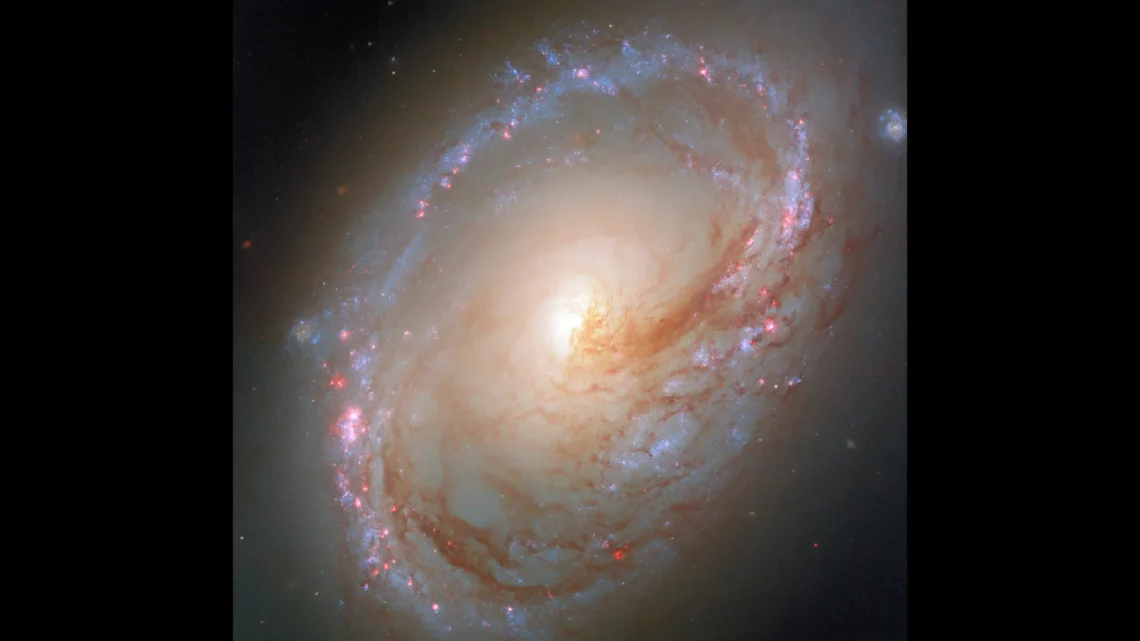<!-- Top Science News -->
<div class="head no-print">
<p>Science News</p>
<p>from research organizations</p>
</div>
<hr class="head-rule no-print"/>
<dl class="dl-horizontal dl-custom">
<dt>Date:</dt>
<dd id="date_posted">September 21, 2025</dd>
<dt>Source:</dt>
<dd id="source">ESA/Hubble</dd>
<dt>Summary:</dt>
<dd id="abstract">Hubble’s latest observations of Messier 96 showcase a warped spiral galaxy illuminated by rings of stellar birth. These new insights provide essential understanding of how stars form and influence their surroundings.</dd>
<dt class="no-print">Share:</dt>
<dd class="no-print"></dd>
</dl>
<div class="row">
<div class="col-md-8 col-md-push-4">
<p>FULL STORY</p>
<hr class="hr-fullstory"/>
<div id="story_text" class="hyphenate underline">
<div id="featured">
<figure class="mainimg">
<img class="img-responsive" src="https://www.sciencedaily.com/images/1920/messier-96-hubble-space-telescope.webp"
srcset="https://www.sciencedaily.com/images/600/messier-96-hubble-space-telescope.webp 600w,
https://www.sciencedaily.com/images/1200/messier-96-hubble-space-telescope.webp 1200w,
https://www.sciencedaily.com/images/1920/messier-96-hubble-space-telescope.webp 1920w"
sizes="(max-width: 600px) 100vw, (max-width: 1200px) 100vw, 100vw"
width="1200" height="675"
alt="Baby Stars Revealed in a Galaxy Torn by Gravity"
decoding="async" fetchpriority="high" loading="eager"/>
<figcaption>The lopsided spiral Messier 96 glows in this stunning new Hubble image, displaying bright pink rings of newborn stars and the striking impacts of gravitational forces shaping its unique form. Credit: ESA/Hubble & NASA, F. Belfiore, D. Calzetti</figcaption>
</figure>
<br/>
</div>
<p id="first" class="lead">This week's highlight from the Hubble Space Telescope features the spiral galaxy Messier 96, known for its unusual shape attributed to a galactic tug-of-war. Located 35 million light-years away in the Leo constellation, Messier 96 is the brightest galaxy in its group. The gravitational influence of nearby galaxies may explain its uneven gas and dust distribution, curved spiral arms, and off-center core.</p>
<div id="text">
<p>This quirky shape is prominently displayed in the latest Hubble image, which combines ultraviolet and optical observations. Previous images of Messier 96 were shared in 2015 and 2018, each contributing valuable data to enhance our understanding of this captivating galaxy.</p>
<p>The current image reveals a fresh perspective on star formation within Messier 96. Pink gas bubbles surround massive, young stars, showcasing a ring of star formation at the galaxy's edges. These emerging stars remain nestled in the gas clouds from which they originated. This updated data will help researchers explore how stars form in dense, dusty environments and how they influence their surroundings.</p>
</div>
</div> </div>
</div> <hr/>
<div id="story_source">
<p><strong>Story Source:</strong></p>
<p><a href="https://esahubble.org/images/potw2534a/" style="text-decoration: underline" rel="noopener noreferrer" target="_blank">Materials</a> provided by <a href="https://esahubble.org" rel="noopener noreferrer" target="_blank"><strong>ESA/Hubble</strong></a>. <em>Note: Content may be edited for style and length.</em></p>
</div> <hr/>
<!-- /related_multimedia -->
<!-- /journal_references -->
<div id="citations">
<div role="tabpanel" class="right-tabs clearfix">
<p class="pull-left"><strong>Cite This Page</strong>:</p>
<div class="tab-content tab-citations">
<p>ESA/Hubble. "Hubble reveals baby stars in a galaxy torn by gravity." ScienceDaily. ScienceDaily, 21 September 2025. <a href="www.sciencedaily.com/releases/2025/09/250921023936.htm">www.sciencedaily.com/releases/2025/09/250921023936.htm</a>.</p>
<p>ESA/Hubble. (2025, September 21). Hubble reveals baby stars in a galaxy torn by gravity. <em>ScienceDaily</em>. Retrieved September 25, 2025 from <a href="www.sciencedaily.com/releases/2025/09/250921023936.htm">www.sciencedaily.com/releases/2025/09/250921023936.htm</a></p>
<p>ESA/Hubble. "Hubble reveals baby stars in a galaxy torn by gravity." ScienceDaily. <a href="www.sciencedaily.com/releases/2025/09/250921023936.htm">www.sciencedaily.com/releases/2025/09/250921023936.htm</a> (accessed September 25, 2025).</p>
</div>
</div>
</div> <br/>
<div class="head">
<h2 id="exploremore_heading" class="pull-left head-left">Explore More</h2>
<p>from ScienceDaily</p>
</div>
<hr class="head-rule"/>
<p>RELATED STORIES</p>
<hr class="hr-fullstory"/>
</div>Summary: This article discusses the latest captivating image from the Hubble Space Telescope, revealing the unique structure of the spiral galaxy Messier 96. Located 35 million light-years away in the constellation Leo, the galaxy shows signs of a galactic tug-of-war, influencing its asymmetric shape and star formation. The detailed observations highlight the birth of new stars within pink gas clouds and how they shape their cosmic environment.




